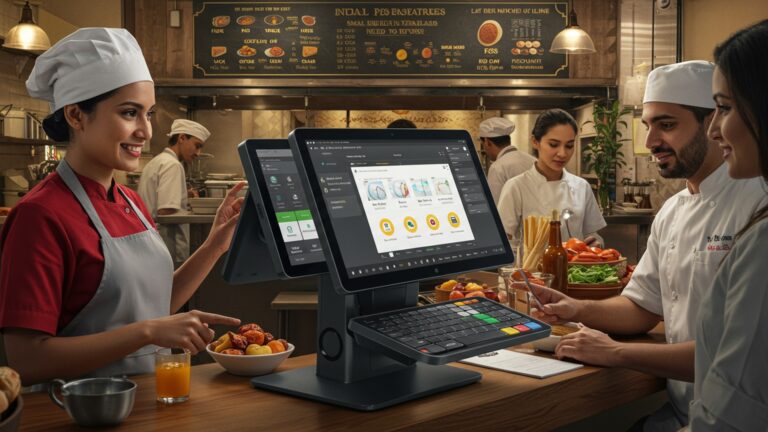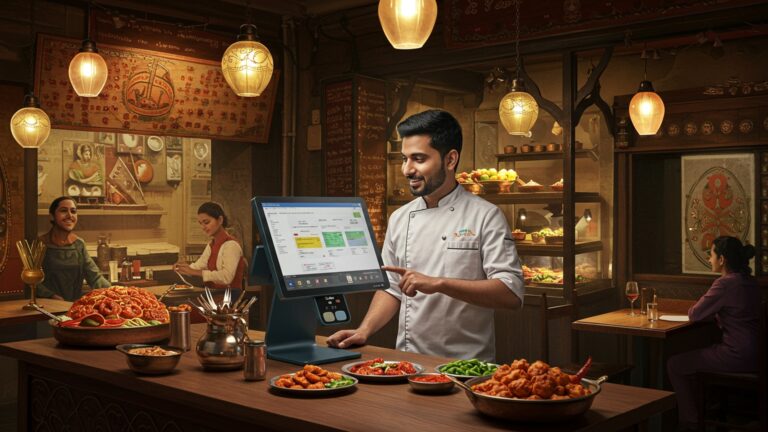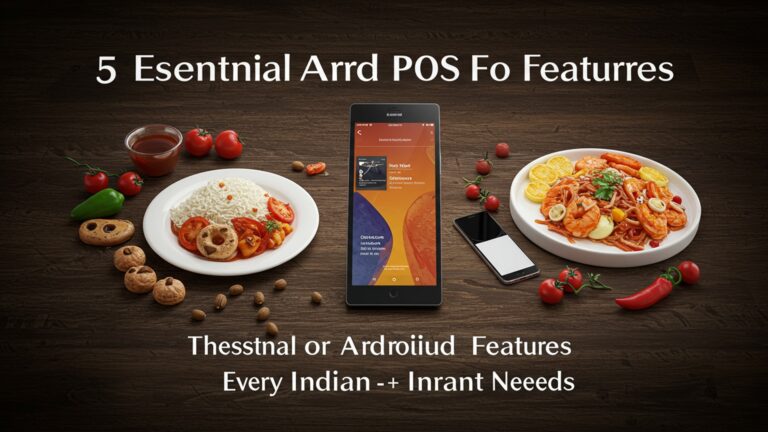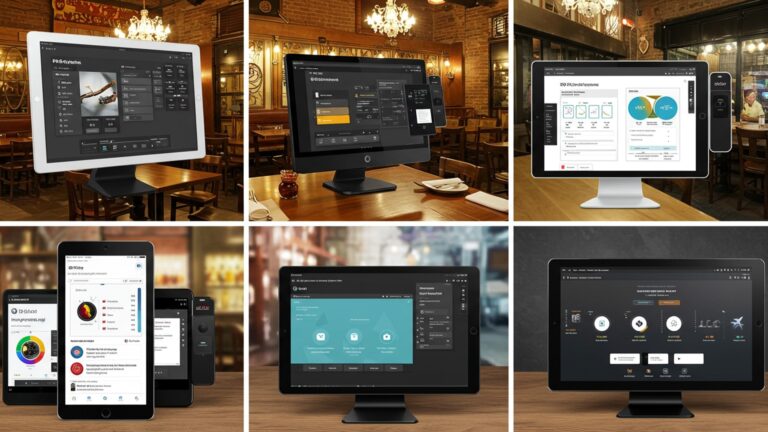5 Essential Android POS Features Every Indian Restaurant Needs
In India’s bustling culinary landscape, where diners increasingly demand seamless experiences and diverse payment options, an efficient Android POS for restaurants India is no longer a luxury but a strategic necessity. Modern Indian eateries, from quick-service chaat corners to fine-dining establishments, face unique operational challenges like managing complex KOTs for regional specialties and integrating with popular delivery aggregators. The latest cloud-based Android POS systems offer real-time inventory tracking for ingredients like paneer and spices, alongside robust UPI and digital wallet payment acceptance, crucial for today’s cashless transactions. Leveraging such technology transforms order management, streamlines billing. provides valuable data analytics, enabling owners to optimize service and boost profitability in a competitive market.

1. Intuitive Order Management and Kitchen Order Ticketing (KOT) System
For any Indian restaurant, managing orders efficiently is the bedrock of smooth operations and customer satisfaction. An intuitive order management system, a core component of an effective Android POS for restaurants India, streamlines the entire process from order taking to kitchen execution. This feature isn’t just about recording what a customer wants; it’s about optimizing the flow, reducing errors. speeding up service.
Key Components and Functionality:
- Digital Menu Display: Staff can easily browse through menu items, view real-time availability. apply custom modifiers (e. g. , “extra spicy,” “no onion,” “add cheese”) directly from a tablet or smartphone. This significantly reduces miscommunication common with handwritten notes.
- Table Management: Visual layouts of your restaurant’s floor plan allow staff to assign orders to specific tables, split bills, transfer tables. track the status of each table (e. g. , occupied, waiting for food, paid).
- Kitchen Order Ticketing (KOT): Once an order is placed, it’s immediately sent to the relevant kitchen or bar stations. This digital KOT system replaces traditional paper slips, ensuring clarity, reducing delays. providing an accurate time stamp for each order. Some advanced systems even allow for color-coding based on preparation time or order priority.
- Order Splitting and Merging: Indian dining often involves large groups and shared meals. A robust POS allows for easy splitting of bills by item or by person. merging orders from different tables if guests decide to combine.
Real-world Application:
Consider a busy Saturday night at a popular Indian restaurant. A server takes an order for a family of six, including specific modifications for several dishes. Instead of scribbling on a notepad, they input everything into an Android tablet. The order for ‘Paneer Butter Masala – less spicy’ goes to the main kitchen, while ‘Masala Chai’ goes directly to the beverage counter. This simultaneous dispatching dramatically cuts down preparation time. In an actual case study, a multi-cuisine restaurant in Mumbai reported a 20% reduction in order processing errors and a 15% improvement in table turnover after implementing a digital KOT system within their Android POS for restaurants India.
2. Integrated Inventory Management
Managing inventory is a critical, yet often overlooked, aspect of restaurant profitability, particularly for Indian cuisine with its diverse ingredients and fluctuating prices. An integrated inventory management system within an Android POS for restaurants India empowers owners to track raw materials, finished goods. manage waste effectively, directly impacting the bottom line.
Key Components and Functionality:
- Real-time Stock Tracking: Every time a dish is sold, the system automatically deducts the corresponding raw materials from inventory. This provides an accurate, up-to-the-minute view of stock levels for ingredients like spices, vegetables, dairy. meat.
- Recipe Management: Define precise recipes for each menu item, detailing the exact quantities of ingredients required. This ensures consistency in food preparation and accurate stock deduction.
- Vendor Management: Track supplier details, purchase orders, delivery schedules. payment terms. Some systems can even generate automated reorder alerts when stock levels fall below predefined thresholds.
- Waste Management: Record spoilage, breakages. expired items. This data is crucial for identifying areas of inefficiency and improving operational practices.
- Cost of Goods Sold (COGS) Calculation: By accurately tracking ingredient costs and usage, the POS can provide precise COGS for each dish, helping in menu pricing and profitability analysis.
Comparison: Manual vs. Integrated Inventory
| Feature | Manual Inventory Management | Integrated Android POS Inventory |
|---|---|---|
| Accuracy | Prone to human error, delays in updates. | Real-time, automated deductions, high accuracy. |
| Time Efficiency | Labor-intensive, requires physical counts. | Automated tracking, significant time savings. |
| Waste Reduction | Difficult to pinpoint sources of waste. | Identifies high-waste items, helps optimize ordering. |
| Cost Control | Estimates often lead to over/under ordering. | Precise COGS, prevents overstocking and stockouts. |
| Data Insights | Limited historical data for analysis. | Comprehensive data for informed purchasing decisions. |
Actionable Takeaway:
By leveraging an integrated inventory system, a restaurant can significantly reduce food waste, which globally accounts for a substantial portion of food costs. For instance, a small eatery in Delhi that introduced an Android POS for restaurants India with inventory management found they could reduce their monthly vegetable spoilage by 10% by tracking usage patterns and adjusting purchase orders accordingly.
3. Flexible Payment Options and UPI Integration
In India’s rapidly evolving digital economy, offering diverse and seamless payment options is non-negotiable for any successful restaurant. An advanced Android POS for restaurants India must support not just traditional card payments but also the widely adopted digital payment methods, with Unified Payments Interface (UPI) integration being paramount.
Key Components and Functionality:
- Cash and Card Payments: Standard functionality, allowing for efficient processing of cash transactions and integration with various card swipe machines (EDC terminals) for credit and debit cards.
- UPI Integration: This is crucial. The POS should generate dynamic QR codes for each bill, allowing customers to pay directly from their preferred UPI app (Google Pay, PhonePe, Paytm, BHIM, etc.). Payments are instantly reconciled, eliminating manual verification and errors.
- Mobile Wallets: Support for popular mobile wallets like Paytm, Amazon Pay. others that are frequently used by Indian consumers.
- Contactless Payments: Integration with NFC (Near Field Communication) enabled devices for tap-to-pay options, offering speed and convenience.
- Payment Gateway Integration: For online orders and delivery, the POS should seamlessly integrate with payment gateways to process secure transactions.
The Power of UPI:
UPI has revolutionized digital payments in India. According to the National Payments Corporation of India (NPCI), UPI processed over 13. 41 billion transactions in December 2023 alone, amounting to ₹19. 64 lakh crore. This staggering volume underscores its ubiquity. An Android POS for restaurants India that doesn’t fully embrace UPI integration is missing out on a vast segment of tech-savvy customers and efficient transaction processing. The instant reconciliation of UPI payments also simplifies accounting and reduces the chances of payment discrepancies.
Use Case:
Imagine a customer at a cafe in Bengaluru finishing their meal. Instead of waiting for a card machine or fumbling for cash, the server presents an Android tablet displaying a QR code. The customer scans it with their PhonePe app, the payment is instantly processed. a digital receipt is generated. This frictionless experience enhances customer satisfaction and streamlines the checkout process, allowing staff to serve more guests efficiently.
4. Customer Relationship Management (CRM) and Loyalty Programs
In a competitive market like India’s, retaining customers is often more cost-effective than acquiring new ones. An Android POS for restaurants India that incorporates robust CRM functionalities and loyalty programs can transform one-time visitors into loyal patrons, fostering a strong community around your brand.
Key Components and Functionality:
- Customer Database: Capture essential customer details such as name, contact details, birth dates, dining preferences. order history. This data is invaluable for personalized marketing.
- Loyalty Programs: Implement various loyalty schemes directly through the POS. This could include point-based systems (e. g. , earn 1 point for every ₹100 spent), tiered rewards, or special discounts for repeat visits. Customers can track their points and redeem rewards directly at the POS.
- Personalized Marketing: Utilize customer data to send targeted promotions via SMS or email. For example, a customer who frequently orders biryani could receive a special offer on a new biryani variant, or a birthday discount.
- Feedback Management: Integrate mechanisms for customers to provide feedback directly through the POS, or link to online review platforms. This allows restaurants to quickly address concerns and improve service quality.
- Segmentation: Categorize customers based on their spending habits, frequency of visits, or preferred menu items. This enables more precise and effective marketing campaigns.
Case Study:
A chain of South Indian restaurants in Chennai implemented an Android POS for restaurants India with an integrated loyalty program. They offered a “Dosa Delights” points system where customers earned points for every purchase, redeemable for free dosas or discounts on combo meals. Within six months, they observed a 25% increase in repeat customer visits and a 15% rise in average transaction value among loyalty program members. The ability to track customer preferences also allowed them to introduce new menu items that resonated well with their frequent diners.
5. Robust Reporting and Analytics
Data is the new oil. for restaurants, robust reporting and analytics are crucial for making informed business decisions. An advanced Android POS for restaurants India should offer comprehensive insights into sales, inventory, staff performance. customer behavior, empowering owners to optimize operations and drive profitability.
Key Components and Functionality:
- Sales Reports: Detailed breakdowns of sales by day, week, month, specific menu items, categories, payment methods. even by server. This helps identify peak hours, best-selling dishes. revenue trends.
- Inventory Reports: Insights into inventory turnover, spoilage rates, cost of goods sold (COGS) for individual items. ingredient usage. Helps in optimizing purchasing and reducing waste.
- Employee Performance Reports: Track individual server performance, average order value, tip distribution. clock-in/clock-out times. This aids in staff management and performance evaluation.
- Customer Reports: examine customer demographics, popular menu items among loyal customers, average spending. frequency of visits. Feeds directly into CRM for targeted marketing.
- Profitability Analysis: Comprehensive reports that combine sales data with COGS and operational expenses to provide a clear picture of overall business profitability.
- Customizable Dashboards: Many modern Android POS for restaurants India offer customizable dashboards, allowing owners to view key performance indicators (KPIs) at a glance, tailored to their specific needs.
Actionable Insights from Data:
Consider a fine-dining Indian restaurant in Goa. By analyzing their POS reports, they discover that their “Seafood Curry” is a top-seller during weekends but sells poorly on weekdays. This insight allows them to adjust their marketing efforts, perhaps promoting it as a “Weekend Special,” and also to optimize ingredient ordering to prevent spoilage during slower days. Moreover, sales reports might reveal that servers who upsell desserts consistently have higher average bill values, prompting targeted training for other staff members. This data-driven approach moves restaurant management from guesswork to strategic decision-making.
Conclusion
In the vibrant, fast-paced world of Indian restaurants, an Android POS system is no longer a luxury but a strategic necessity. Embracing features like lightning-fast order processing, seamless digital payment integrations (think instant UPI and QR code scans). intelligent inventory management ensures your operations run smoothly, even during the busiest festive season. My personal tip, having observed many successful eateries, is to prioritize a system that truly simplifies staff workflows; when your team isn’t battling clunky software, they can genuinely focus on enhancing the customer experience, making every guest feel valued. Don’t just settle for basic billing; actively seek a system that offers real-time analytics to refine your menu and minimize wastage, a crucial factor in India’s competitive F&B market. Evaluating your current setup against these modern necessities is your next actionable step. By investing in an Android POS that truly understands the unique rhythm of an Indian restaurant, you’re not just buying software – you’re building a foundation for sustainable growth, exceptional service. a thriving business. Learn more about how to optimize your restaurant with smart POS solutions. How to Optimize Your Restaurant with Smart POS Software Solutions
More Articles
Discover 7 Essential Features for Your Restaurant Billing Software in India
Master Android POS Software for Seamless Business Management
A Guide to 10 Essential Online Ordering POS Systems in India
Learn How Mobile POS Software Boosts Sales and Customer Experience
FAQs
Why should an Indian restaurant even consider an Android POS system?
An Android POS makes managing your restaurant a whole lot simpler! It streamlines everything from taking orders and tracking inventory to speeding up billing and understanding your sales data better. Ultimately, it leads to happier customers and a much smoother operation.
How does an Android POS help with taking orders in a busy Indian restaurant?
Imagine your waiters taking orders directly on a tablet! It sends orders straight to the kitchen, drastically reduces errors. helps manage tables efficiently, especially during those crazy rush hours. No more scribbled notes or forgotten dishes.
What’s the big deal about KOT/KDS for an Indian kitchen?
For an Indian kitchen with its diverse menu and specific modifications, a KOT (Kitchen Order Ticket) or KDS (Kitchen Display System) is a game-changer. It ensures every order, including crucial details like ‘less spicy’ or ‘extra paneer,’ reaches the kitchen accurately and on time, boosting efficiency and cutting down on food waste.
Can an Android POS really help me keep track of all my spices and ingredients?
Absolutely! A good POS system helps you keep tabs on your entire inventory, from atta and rice to specific masalas and vegetables. You’ll know exactly what you have, what’s running low. can even track ingredient usage per dish, making reordering a total breeze.
Is it easy to handle different payment methods like UPI with these systems?
Yes, modern Android POS systems are designed with India in mind! They seamlessly integrate with UPI, cash, card payments. even make it super simple to split bills. This makes checkout incredibly quick and convenient for your customers.
What kind of useful insights can I get from a POS system about my restaurant’s performance?
You can pull fantastic reports on sales trends, your most popular dishes, peak business hours. even server performance. This data is invaluable for making smarter decisions about your menu, staffing. promotions to really grow your business.
Why is an Android POS a particularly good fit for Indian restaurants compared to other options?
Android POS systems are generally more affordable, incredibly flexible. benefit from a huge ecosystem of compatible hardware. This combination makes them a cost-effective and highly adaptable choice for Indian restaurants, whether you’re a small chai stall or a large fine-dining establishment.






